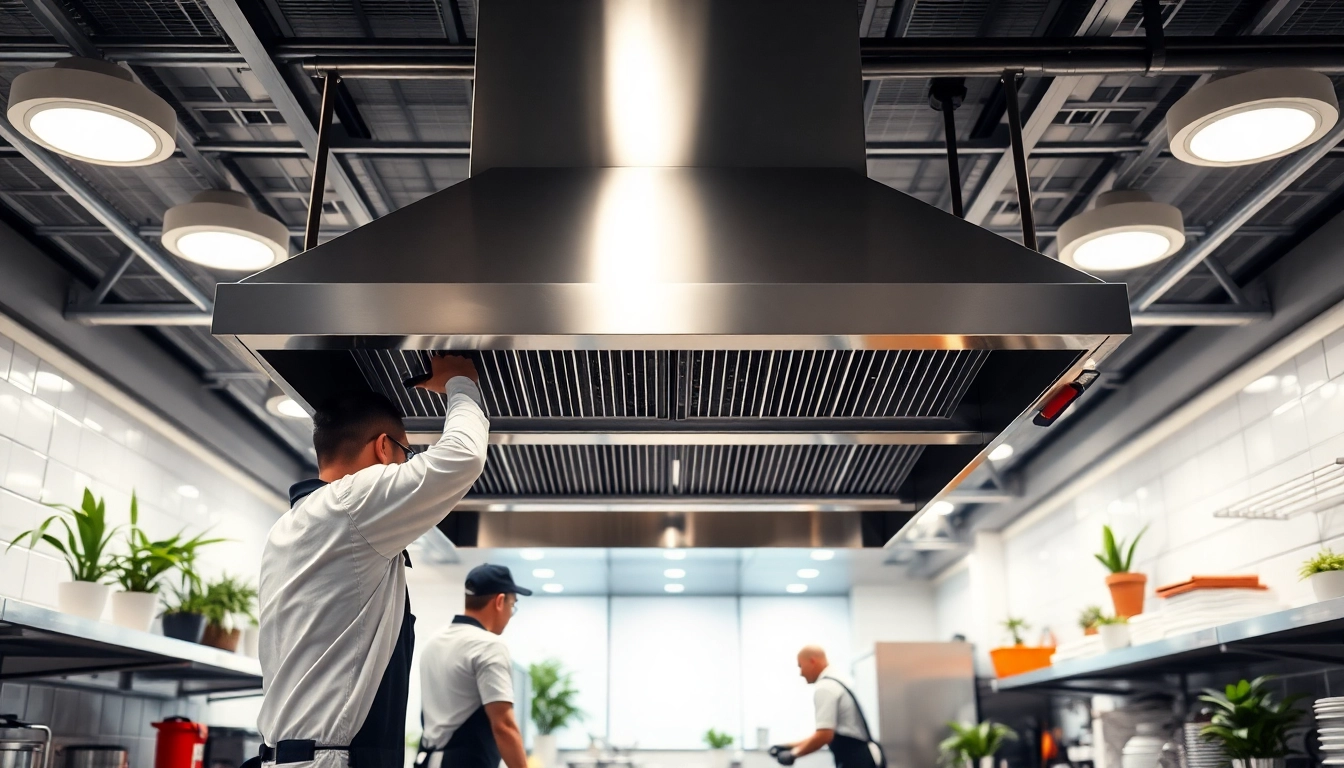Understanding Restaurant Exhaust Hood Cleaning Service
The kitchen in any restaurant operates under intense conditions. High temperatures, steam, grease, and smoke are an everyday reality. One critical component that helps manage these aspects is the exhaust hood system. However, to ensure its optimal performance and compliance with health standards, regular maintenance is paramount. This is where a comprehensive Restaurant Exhaust Hood Cleaning service comes into play. Understanding what this service entails is essential for restaurant owners who prioritize safety and efficiency in their operations.
Importance of Regular Cleaning
Regular cleaning of exhaust hoods is not merely a matter of compliance; it’s about safety, efficiency, and brand reputation. Grease accumulates in the exhaust system over time. If left unaddressed, this build-up can pose serious fire hazards. According to the National Fire Protection Association (NFPA), a staggering number of kitchen fires stem from grease accumulation. Regular cleaning helps mitigate this risk, making the kitchen a safer place for staff and customers alike.
Moreover, a clean exhaust system improves air quality and enhances kitchen ventilation. This can lead to a more comfortable working environment for chefs and cooking staff, reducing heat stress and enhancing overall productivity. Additionally, clean systems ensure that kitchen equipment operates efficiently, reducing energy costs and minimizing equipment repairs or replacements over time.
What to Expect from the Service
When you engage a professional Restaurant Exhaust Hood Cleaning service, several steps are generally followed to ensure thorough cleaning. First, a preliminary inspection is conducted to gauge the extent of cleaning required. This often includes assessing the exhaust system, including hoods, filters, and ducts.
Next, a cleaning plan is devised. This plan typically involves disassembling the exhaust components to access difficult areas. The technicians use appropriate cleaning agents and tools to remove grease, grime, and other build-up. Special attention is paid to areas that experience the highest levels of grease accumulation, including the filters and canopy. Post-cleaning, a final inspection ensures that everything has been cleaned thoroughly and meets quality standards.
Common Misconceptions
Despite the importance of exhaust hood cleaning, misconceptions abound. One common myth is that periodic cleaning is sufficient for maintaining safety and compliance. However, the frequency of cleaning should depend on factors such as cooking volume and types of food prepared. Restaurants with high frying or grilling volumes will generally require more frequent service than establishments with lower cooking activity.
Another misconception is that DIY cleaning is sufficient. While basic maintenance tasks can be performed by restaurant staff, like cleaning filters and hoods, a professional service encompasses deep cleaning necessary for ensuring safety and compliance with health regulations. Regular professional cleaning can detect issues that are not visible and can ensure proper operation of the exhaust system.
Signs Your Kitchen Requires Restaurant Exhaust Hood Cleaning Service
Indicators of Build-Up
Recognizing the signs of grease and grime build-up is crucial for maintaining a safe kitchen environment. Some of the most common indicators include:
- Visible Grease Accumulation: If there are noticeable grease spots on the hoods or walls, it’s a clear sign that the exhaust system requires immediate cleaning.
- Unpleasant Odors: Lingering smells of burnt oil or other food particles often signify that grease has built up in the exhaust system.
- Reduced Airflow: When the ventilation system struggles to expel smoke or steam, it may be blocked by grease accumulation.
- Water Dripping from Hoods: If water is dripping from the exhaust hood, it can indicate that the system is not functioning efficiently and needs attention.
Health Risks Associated with Neglect
Neglecting exhaust hood cleaning can lead to serious health risks for both staff and patrons. Over time, grease and debris can harbor bacteria that can contaminate food and contribute to health code violations. Poor ventilation can also lead to respiratory issues among kitchen staff, as airborne grease particles become prevalent. Furthermore, excessive heat and smoke can create an uncomfortable working atmosphere, potentially leading to accidents and injuries.
Impact on Kitchen Operations
A neglected exhaust hood can directly affect kitchen operations. When exhaust systems do not function correctly, kitchen temperatures rise, leading to decreased productivity and increased discomfort for staff. Moreover, the likelihood of kitchen fires increases significantly, which can lead to devastating losses, both financially and in terms of reputation. Maintaining a well-functioning exhaust system ensures a smoother workflow, allowing chefs to focus on cooking quality meals rather than worrying about safety hazards.
Choosing the Right Restaurant Exhaust Hood Cleaning Service
Key Qualities to Look For
Choosing a reliable Restaurant Exhaust Hood Cleaning service is crucial for ensuring quality and compliance. Here are some essential qualities to look for:
- Certification and Training: Ensure the service provider has certified technicians trained in the latest cleaning practices and safety protocols associated with exhaust cleaning.
- Experience and Expertise: Look for a company with significant experience in the industry. Experienced providers are more likely to understand the specific needs of different types of restaurants.
- Comprehensive Services: Opt for a service that offers a full range of cleaning services, including kitchen equipment, ducts, and more, rather than just superficial cleaning.
- Positive Reputation: Client testimonials and reviews can provide valuable insights into the effectiveness and reliability of the service.
Questions to Ask Potential Service Providers
Before selecting a provider, it’s beneficial to ask them relevant questions. Here are some examples:
- What cleaning methods do you employ, and are they compliant with local regulations?
- How often do you recommend cleaning our exhaust system, considering our restaurant’s cooking volume?
- Can you provide references or testimonials from other clients you have worked with?
- What kind of guarantee do you provide for your services?
Evaluating Customer Reviews
Customer reviews can significantly influence your decision when selecting a Restaurant Exhaust Hood Cleaning service. Look for detailed feedback that mentions the quality of service, professionalism, and reliability. Pay attention to any recurring issues mentioned by customers, as these can provide insights into the provider’s consistency and effectiveness. Platforms such as Google Reviews, Yelp, and local business directories can offer a well-rounded view of a service’s reputation.
Best Practices for Maintaining Kitchen Hygiene
Daily Maintenance Tips
Daily maintenance is vital for minimizing grease build-up and keeping the kitchen safe. Here are some best practices:
- Wipe down surfaces with degreaser regularly to prevent grease accumulation.
- Clean filters weekly, especially in high-traffic kitchens that use frying or grilling techniques.
- Ensure staff are trained to report any visible grease build-up or unusual odors immediately.
- Keep buckets for grease disposal handy for staff to use post-cooking.
Scheduling Regular Professional Cleanings
In addition to daily maintenance, scheduling regular professional cleanings is necessary. The frequency of these cleanings depends on the volume and type of food cooked. A general rule of thumb is to have exhaust systems cleaned every 1 to 3 months for high-volume kitchens, while other establishments may consider every 6 months. Creating a cleaning schedule can ensure that your kitchen maintains compliance with health regulations while minimizing fire hazards.
Utilizing Proper Cooking Techniques
Implementing best practices in cooking techniques can also reduce the amount of grease produced in the kitchen. This includes:
- Utilizing lids on pots and pans during cooking to contain splatter.
- Avoiding excessive oil in frying processes to minimize splatter.
- Adopting efficient cooking methods that generate less smoke and steam.
Measuring the Effectiveness of Your Restaurant Exhaust Hood Cleaning Service
Performance Metrics to Monitor
To ensure that your investment in a Restaurant Exhaust Hood Cleaning service is effective, consider monitoring several performance metrics:
- Air Quality: Conduct periodic air quality tests in your kitchen to ensure that harmful particles are not circulating.
- Compliance Scores: Keep track of inspection scores and feedback from health inspectors, focusing on any issues tied to your exhaust system.
- Frequency of Fires: A reduction in overall kitchen incidents, particularly fires, can be a clear indicator of effective cleaning.
Feedback from Restaurant Staff
Regular feedback from your kitchen staff can also help assess the effectiveness of your cleaning service. Pay attention to their comments about ventilation, air quality, and overall comfort within the kitchen. Staff should feel comfortable reporting any airflow issues or visible grease build-up to ensure ongoing safety and compliance.
Compliance with Health Regulations
Finally, ensuring compliance with local health regulations is paramount. Local health departments often have stringent guidelines governing the cleanliness and maintenance of exhaust systems. Regularly checking that your service provider is compliant with these regulations ensures that your restaurant remains within legal boundaries and avoids potential fines or closings.



